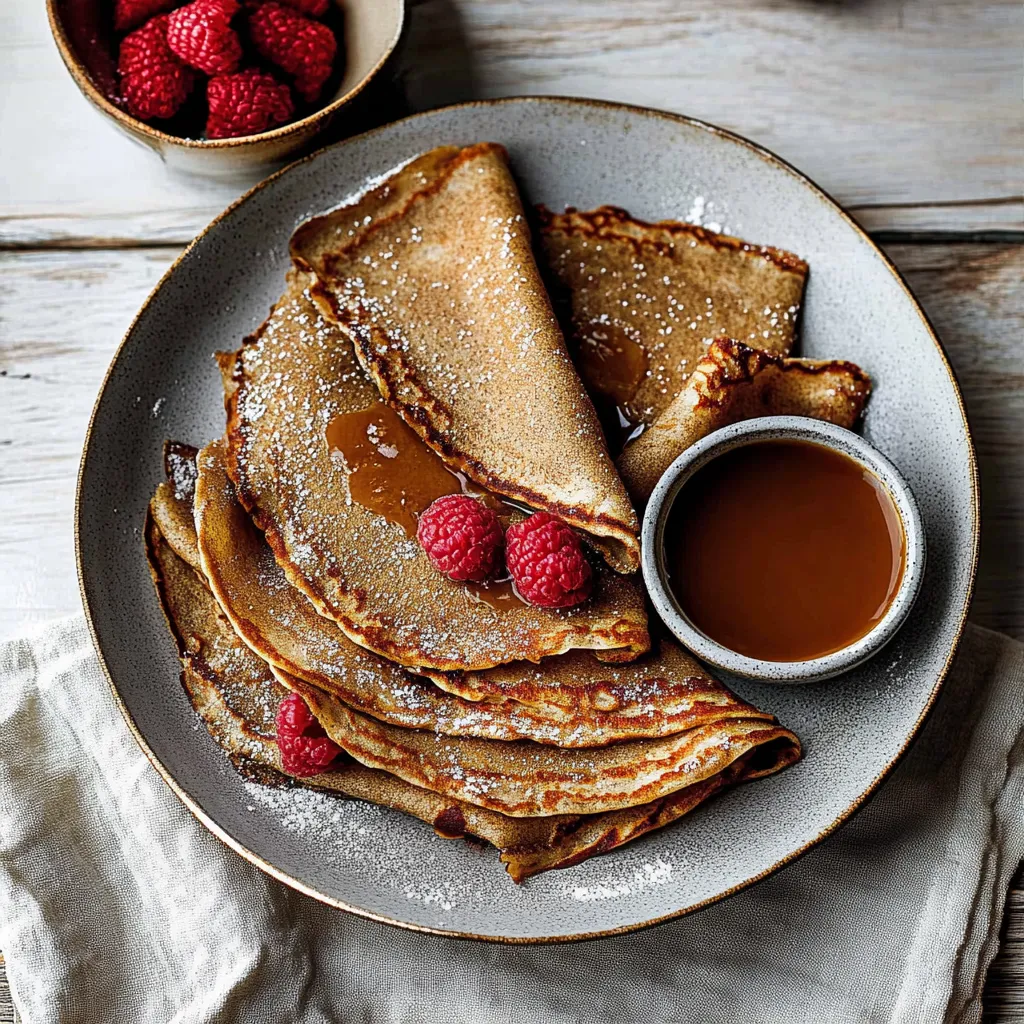 Bookmark
Bookmark
This buckwheat crepe recipe transforms a simple breakfast into something extraordinary with its nutty flavor and luscious dulce de leche filling. The combination creates a perfect balance between earthy buckwheat and sweet caramel that will make your taste buds dance.
I first made these crepes during a rainy Sunday morning when I was craving something special but didn't want to leave the house. The nutty aroma of buckwheat filled my kitchen, and now these crepes have become our favorite weekend tradition.
Ingredients
- Buckwheat flour provides a distinctive nutty flavor and beautiful color that makes these crepes special
- Eggs act as the binding agent and give structure to the delicate crepes
- Milk creates tenderness and helps achieve the perfect consistency
- Melted butter adds richness and prevents sticking while cooking
- Maple syrup brings subtle sweetness that complements the earthy buckwheat
- Salt enhances all flavors and balances the sweetness
- Water for thinning if needed ensures you get the perfect crepe consistency
- Ghee for cooking gives a beautiful golden color and subtle nutty flavor
- Dulce de leche creates a luxurious caramel filling that transforms these into a special treat
Step-by-Step Instructions
- Blend the Batter
- Combine buckwheat flour, eggs, milk, butter, maple syrup, and salt in your blender and process until completely smooth with no lumps. The blender method ensures perfect incorporation of ingredients. If you don't have a blender, whisk vigorously in a bowl until smooth.
- Rest the Batter
- Cover the batter and refrigerate for at least 1-2 hours or overnight. This resting period is crucial as it allows the flour to fully hydrate and the gluten to relax, resulting in more tender crepes that won't tear when cooking.
- Prepare for Cooking
- When ready to cook, check your batter consistency. It should flow like heavy cream. If it seems too thick, add a small amount of water to thin it out. The proper consistency ensures thin, delicate crepes rather than thick, pancake-like results.
- Heat and Grease Pan
- Preheat your crepe pan or non-stick skillet over medium-high heat until hot but not smoking. Add a small amount of ghee or butter and swirl to coat the surface. The right temperature is key here—too hot and the crepes will burn before cooking through, too cool and they'll stick.
- Pour and Swirl Batter
- Pour approximately 1/4 cup of batter into the center of the hot pan while simultaneously lifting and swirling the pan to create a thin, even layer of batter. Work quickly but carefully to ensure even coverage before the batter sets.
- Cook First Side
- Allow the crepe to cook for 1-2 minutes until the edges begin to brown slightly and the center appears dry. You'll notice the edges starting to lift from the pan when it's ready to flip. Patience here results in perfect color and texture.
- Flip and Finish
- Gently slide a thin spatula under the crepe and flip it with confidence. Cook the second side for another 1-2 minutes until golden spots appear. The second side typically cooks faster than the first, so watch carefully.
- Stack and Keep Warm
- Transfer finished crepes to a plate, stacking them directly on top of each other. Cover with a clean kitchen towel to keep them warm and prevent them from drying out. Unlike pancakes, properly cooked crepes won't stick together.
- Fill and Serve
- Spread each crepe with a thin layer of dulce de leche while still warm. You can fold them into quarters or roll them up. Serve immediately for the best experience.
 Bookmark
Bookmark
Buckwheat flour is actually not a grain but a seed related to rhubarb, which gives it that distinctive earthy flavor I love so much. The first time I served these to my daughter, she declared them "fancy pancakes" and now requests them for her birthday breakfast each year.
Make-Ahead Options
These crepes work wonderfully as a make-ahead meal. The batter can be prepared up to 48 hours in advance and kept refrigerated in an airtight container. This actually improves the texture as the flour fully hydrates. You can also cook all the crepes ahead of time, stack them with small pieces of parchment between each one, wrap the stack in plastic wrap, and refrigerate for up to 3 days. Reheat them briefly in a warm pan before filling and serving.
Perfect Pairings
While dulce de leche makes an incredible filling, these versatile buckwheat crepes work beautifully with both sweet and savory fillings. For breakfast, try fresh berries and whipped cream or nut butter and sliced bananas. For a savory lunch option, fill them with ham and gruyère cheese or sautéed mushrooms and herbs. The nutty flavor of buckwheat complements most ingredients, making these crepes a blank canvas for creativity.
Cultural Background
Buckwheat crepes, known as "galettes" in French cuisine, originate from Brittany in northwestern France. Traditionally, they're served with savory fillings while sweet fillings are reserved for wheat flour crepes. This adaptation brings together the rustic French tradition with the Latin American dulce de leche for a delightful fusion that honors both culinary heritages. In Brittany, these crepes were historically everyday food for farmers, showing how humble ingredients can create extraordinary meals.
Recipe FAQs
- → Can I make the crepe batter ahead of time?
Yes, the batter actually benefits from resting time. You can make it up to 24 hours in advance and store it covered in the refrigerator. This resting period allows the flour to fully hydrate and results in more tender crepes.
- → What can I substitute for dulce de leche?
If dulce de leche isn't available, you can use caramel sauce, Nutella, fruit preserves, or even a combination of fresh fruits and whipped cream. For a savory option, try cheese and ham or sautéed vegetables.
- → Are buckwheat crepes gluten-free?
Pure buckwheat flour is naturally gluten-free, despite its name suggesting otherwise. However, to ensure your crepes are completely gluten-free, verify that your buckwheat flour is certified gluten-free as cross-contamination can occur during processing.
- → Why is my crepe batter too thick?
Buckwheat flour can absorb more liquid than regular flour. If your batter seems too thick after resting, simply add water a tablespoon at a time until it reaches the consistency of heavy cream. The batter should coat the back of a spoon but run off easily.
- → How do I prevent my crepes from tearing when flipping?
Make sure the crepe is cooked enough on the first side before attempting to flip it. It should appear dry on top and golden underneath. Use a thin, flexible spatula and make sure your pan is properly greased. If crepes continue to tear, your batter might be too thin or your pan temperature too high.
- → Can I freeze these crepes?
Yes, cooked crepes freeze well. Place pieces of parchment paper between each crepe, then stack and wrap tightly in plastic wrap and foil. Freeze for up to 2 months. Thaw overnight in the refrigerator and warm gently before filling and serving.
